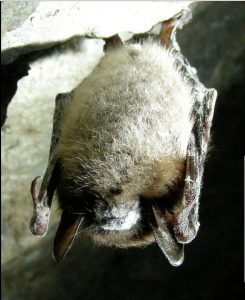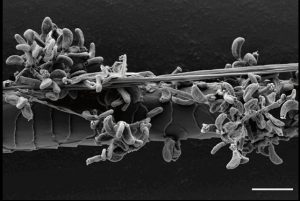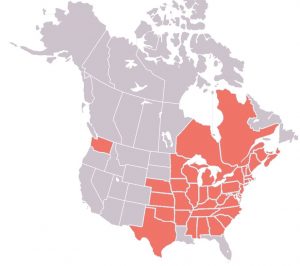For many years, one of my favourite things to do on a summer’s evening was to watch for the bat’s to come out about a half an hour after the Sun went down. To be honest I usually combined this with some backyard stargazing, but still the bats were certainly fun to watch. One of the most interesting parts was the timing, the bats always appeared just a few minutes after the last bird flew to its roost, never before, and never more than ten minutes after.
Over the last few years however my nocturnal flying friends have disappeared, along with millions of other bats throughout eastern North America and the cause has been identified as an epidemic of the fungus Pseudogymnoascus destructans, commonly know as White Nose Syndrome. The first image below shows a Little Brown Bat, Myotis lucifugus, that has been infected by white nose syndrome while the second shows the fungus itself.


Now P. destructans causes harm to bats in several different ways. The most obvious symptom is the fungal growth and lesions around the mouth and on the wings which inhibit the bat’s ability to eat and fly. The fungus is also known to infect the lungs causing respiratory distress.
However it is actually thought that White Nose Syndrome does its greatest harm by interfering with a bat’s winter hibernation. You see during hibernation bats, and other mammals as well, lower their body temperature in order to stretch body fat reserves throughout the winter. The fungus however prevents the bats from entering the torpor stage of hibernation, where the body temperature goes lower, and therefore the animals literally starve to death while trying to hibernate.
P. destructans was first spotted in a cave in New York state back in 2006 and has since spread to 33 states in the U.S. along with 5 provinces of Canada. The effect of the disease has been devastating with a decline of more than 90% in the bat population of caves where the fungus has been for over four years. By 2012, that’s six years ago now, 5-7 million bats are thought to have perished! The image below shows that areas of North American where White Nose Syndrome has been identified.

So where did White Nose Syndrome come from, how did it get here? The answer is simple, Europe. The fungus P. destructans has been known to infect European bats for decades but it seems that the European bats have acquired at least a partial immunity to the disease. It looks as if this is yet another example of a disease whose original population has evolved to survive, leaping into a related population with no immunity and causing a devastating epidemic. Well know examples of this phenomenon are smallpox among the Native Americans and Measles among the Hawaiian Islanders. And I’m afraid that once again Human Beings are probably the transmitters of the disease because it appears that people who like to explore caves, known as spelunking, can get the fungus on their clothing, which can then be passed to other caves they visit, even caves on different continents.

Now I know some of you are saying, who cares about bats? They’re icky anyway! Well remember that bats eat insects, a lot of insects and without bats we’re going to have a lot more destructive, disease carrying insects around! In fact the Forest Service estimates that 1.1 million kilograms of insects will go uneaten. That’s a lot of bugs eating our crops and spreading germs that infect people!
At the moment there is no known way of fighting White Nose Syndrome. There is research underway but only a little. There’s not a lot of funding to combat bat diseases. So, barring a providential discovery we can only hope that, like their European cousins, American bats will acquire the immunity to survive White Nose Syndrome.
